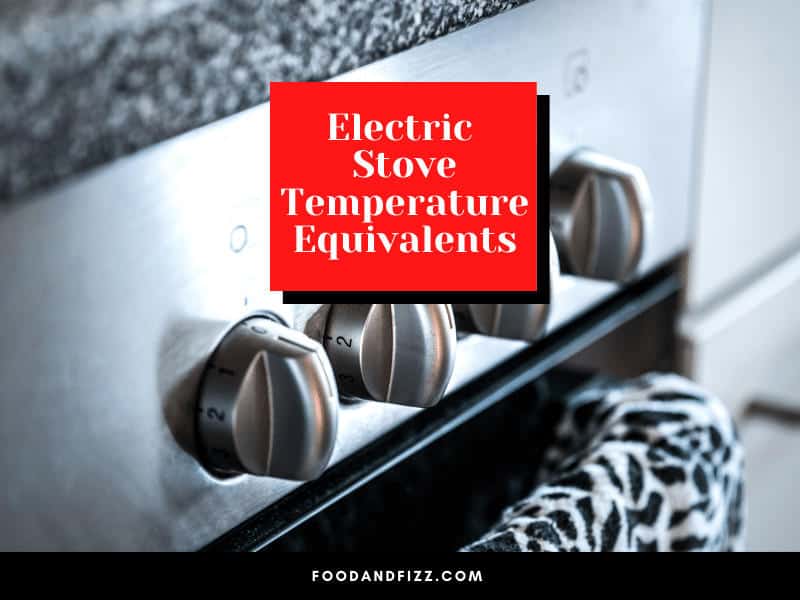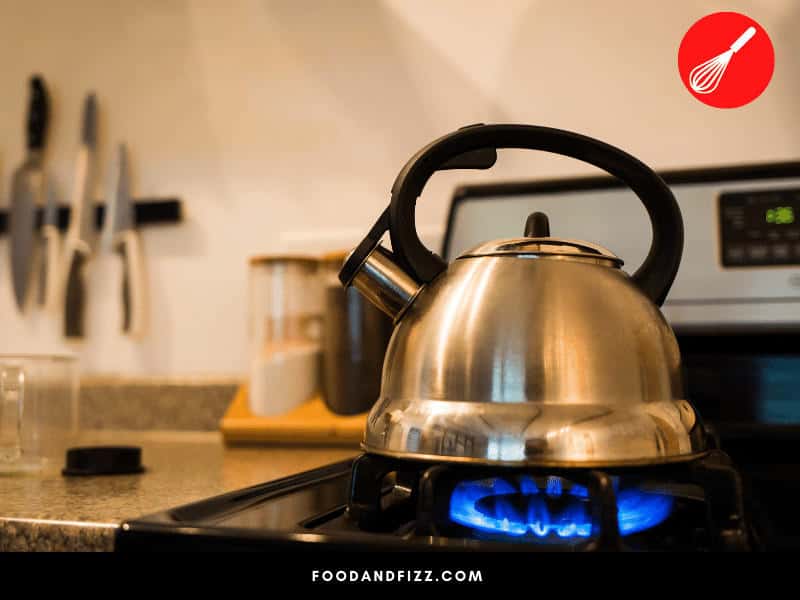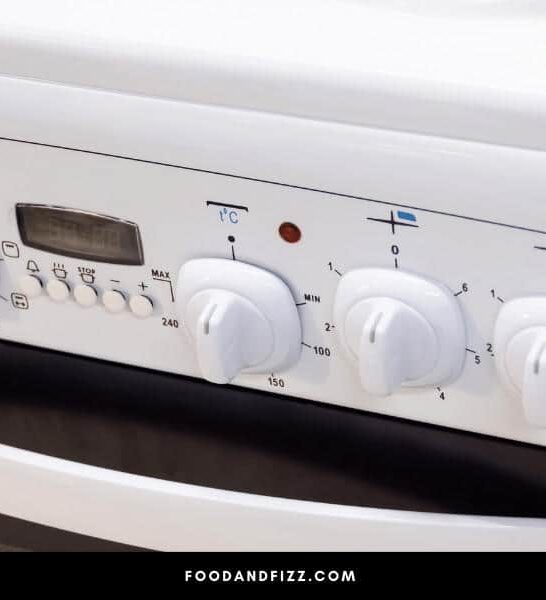It’s all very well when a recipe writer glibly says, “Put the pot on medium heat before adding your [insert ingredient here]. “Yeah, thanks, but what exactly do you mean by ‘medium heat’, dear recipe writer? Would it kill you to be more specific, dagnabbit?”
Electric Stove Temperature Equivalents
Typically, the “low heat” setting on an electric stove sets the corresponding burner to between 200°F and 300°F. A “medium heat” setting generally implies that the cooker will set the corresponding burner to between 300°F and 400°F, while a “high heat” setting indicates a burner setting of between 400°F and 600°F. Please note that these are conventional values; consult your stove’s manual or contact its manufacturer to confirm its temperature settings.

Standard Knobs on Stoves
Unless staffed by what our British friends like to describe rather unflatteringly as “knobs”, your stove’s manufacturer did the decent thing and marked its control knobs from 1 through 9.
If this is the case, translating from the certainty of a well-marked dial to the uncertainty of a careless instruction should be relatively straightforward.
Marks 1-3
Electric stove marks 1 through 3 equate to “low heat,” gradually increasing from the lowest setting, 1, to the highest in the range, 3. This is the setting you would use if you were simmering or slow-cooking a dish.
It’s also the setting that most often results in burnt offerings because, on this setting, cooks get sanguine, feel they have oodles of time before they need to return their attention to the pot, become distracted, then smell something burning.
The upshot is usually that the family will have to tough it out with the unintended appearance of charcoal at the dinner table.

Marks 4-6
Marks 4 through 6 equate to “medium heat”. This is the range in which cooks do most of their frying. Here’s where the steaks, pancakes, omelets, chicken, meats, and vegetables get the special treatment that turns them into mouth-water culinary art. (Well, hopefully, anyway.)
Because this is an active range, usually requiring constant stirring or frequent turning-over of this or that juicy ingredient, there is less risk of the cook forgetting herself and burning the meal.
Many recipes call for a certain amount of jiggery-pokery; for instance, requiring the cook to braise an ingredient to “seal in the taste,” then lower the heat.
Less frequently, cooks may be ordered to go the opposite way, which is to start off on medium heat, then raise the temperature to “high” to finish.
Marks 7-9
Marks 7 through 9 equate to “high heat,” with 9 being the hottest available on most stoves.
High heat is the go-to range for bringing water to a boil, for the early stages of stir-frying, beloved of aficionados of Chinese cooking and yours truly, and for searing meat.
When time is short and hunger pangs have lowered your patience and sense of caution to near-zero levels, this is the temperature range employed to cook off dishes suffering from too much fluid. (By the way, that’s not a great technique. It is much better to pour out the excess liquid and attempt to rejuvenate the dish by adding more of the original base ingredients like vegetables and cubed stocks.)

The In-between Temperature Ranges
Sometimes, it gets worse than a recipe writer saying low, medium, or high heat. You will often come across even fuzzier, potentially more confusing terms I call “the in-betweens” that ask you to set the stove to medium-low or medium-high.
“You’ll be like, lady, make up your cotton pickin’ mind already,” and no doubt, if the writer were unfortunate enough to be around you at the time, she might get a dose of the old spatula-to-the-back-of-the-head treatment (absolutely illegal, by the way, so don’t do it).
Anyhoo, for medium-low, set the control knob to mark 3 or 4. On the majority of electric stoves, this should work a treat. Just be aware of what your recipe writer is trying to achieve and use your senses to double-check that she’d approve.
For example, if you’re not expecting a sizzle but it starts to sizzle, you’re on too high a mark. If you’re expecting it to simmer but it’s not simmering, you’re on too-low a mark.
The best advice I can give you is to cook with your eyes, nose, and tongue. React to what’s happening in front of you, not the letters on the recipe page.
For medium-high, set the control knob to mark 6 or 7, as discussed more fully below.
For simmer, start with a high mark, for example, 6, 7, or 8, to get the bubbling going, then immediately–and by golly, I mean instantly–lower to mark 3 or 4. Watch the contents closely; you don’t want to keep it boiling!
When your pot or pan is simmering, it will produce very gentle, sluggish bubbles, rising like exhausted ghouls after a night of feverish haunting. Anything more exuberant and energetic than that means you’ve got your burner set too high. Lower it by one mark and return to observing your pot or pan.

If You’ve Got One of Those Electric Stoves
Not all electric stove manufacturers assiduously adhere to industry standards, unfortunately. If you’ve got a stove from such a manufacturer, you’ll have to make the necessary adjustments.
For instance, if the knobs on your stove only go as high as mark 6, then marks 1 and 2 are low, 3 and 4 are medium, and 5 and 6 are high. You’ll also want to keep this in mind, and the next time you’re out shopping for an electric stove, no doubt you’ll ensure that you’re getting a stove that doesn’t flout convention, won’t you? 😜
Tips and Tricks on An Electric Stove
The recipe says, “heat the pan on medium-high.” What the heck is that, and how would I know when the pan is ready?
A medium-high heat would be a burner set to mark 6 or 7. Set the knob to one of those marks and place the pan on the burner sans oil. Put in a drop of water (literally, one, or at most, two drops) and wait.
Eventually, the water will start to sizzle, get all bubbly and boisterous, then disappear in a puff of vapor. Ensure that the rest of the pan is as hot as the middle by dribbling a drop or two of water onto the edge of the pan. If it sizzles and quickly disappears, you’re good to go.
How Can I Tell When I Should Start Frying My Sunny-side-up Eggs?
Glad you asked! Don’t use the method outlined above, otherwise, your pan will be too hot, and you’ll probably end up burning your eggs.
This time, pour some oil into the frying pan and place the pan on medium heat. You know the drill, mark 6 or 7. Now watch the oil closely, and wait until it begins to show a convection current (like it’s swirling or roiling).
You’ll know that you waited too long if the oil begins to smoke, in which case, don’t panic, simply take the pan off the burner, let it cool for a minute or two, then try again. Easy!
Pots, Pans, Frying Pans, and Saucepans
One naughty little “gotcha” can easily result in burnt food, and other unexpected, unpleasant results occur when your pot, pan, frying pan, or saucepan behaves unpredictably. This happens because of the differences in each item’s material and thickness.
Not to worry too much.
As you blaze a culinary trail through your kitchen, little by little, you will come to know the peculiarities of all your appliances and utensils. That’s how you become a master chef.

Frequently Asked Questions About Electric Stove Temperature Equivalents
What Temperature is Low Heat on a Stove?
For stoves with standard knobs of 1 through 9, low heat would be equivalent to marks 1-3. If your stove only has 6 knobs, low heat would be marks 1-2.
What is Medium-Low Heat on a Stove?
For most stoves, medium-low heat would correspond to marks 3-4.
What is the Temperature Equivalent for Low, Medium and High Heat?
Low heat would be between 200°F and 300°F. Medium heat would be between 300°F and 400°F, while a high heat setting indicates a burner setting of between 400°F and 600°F

